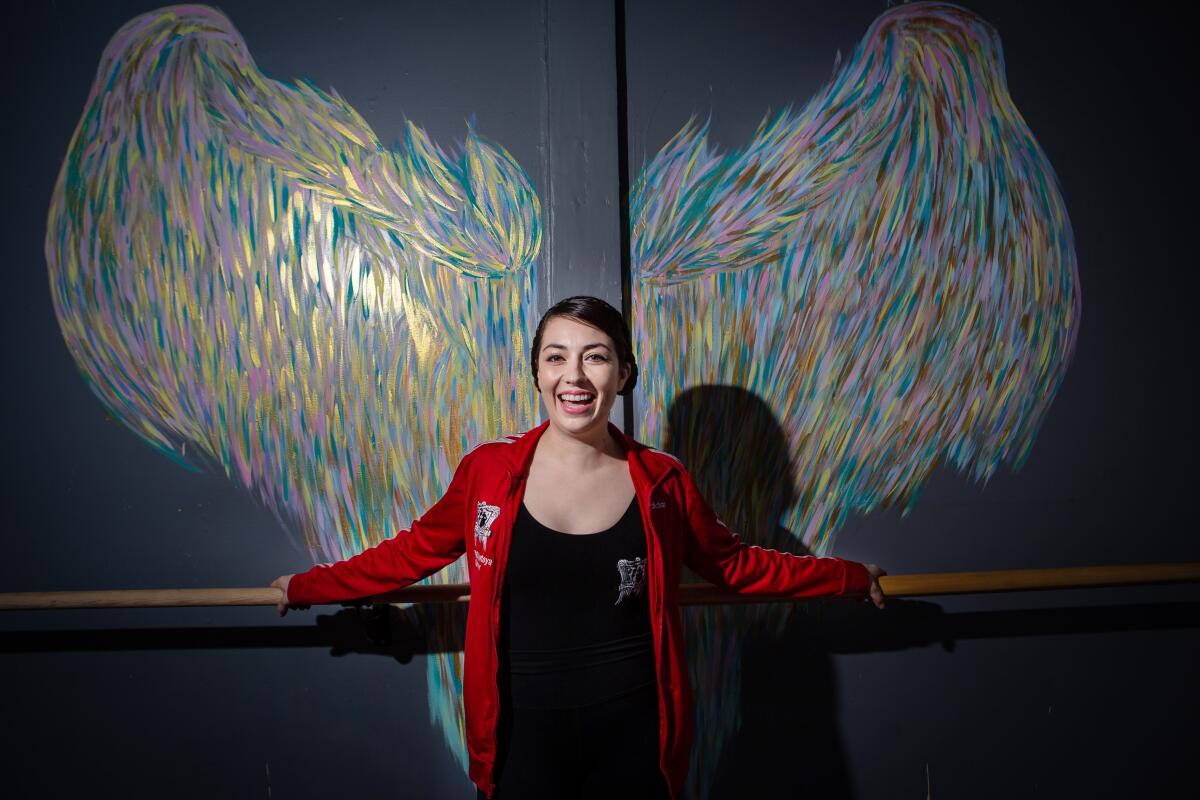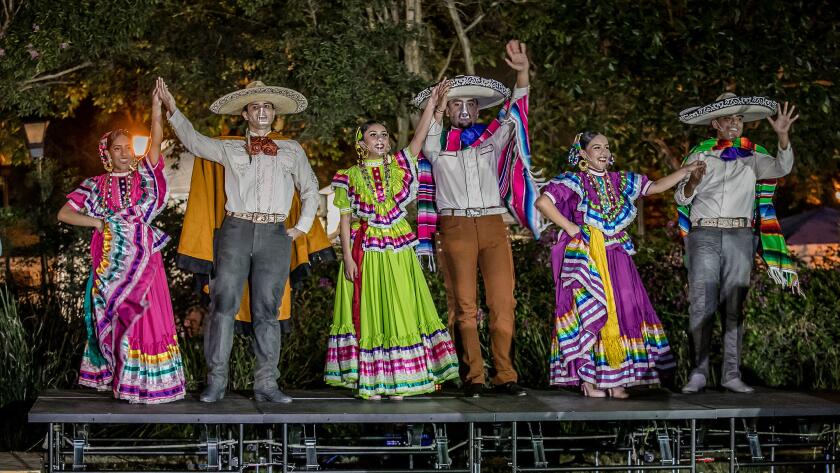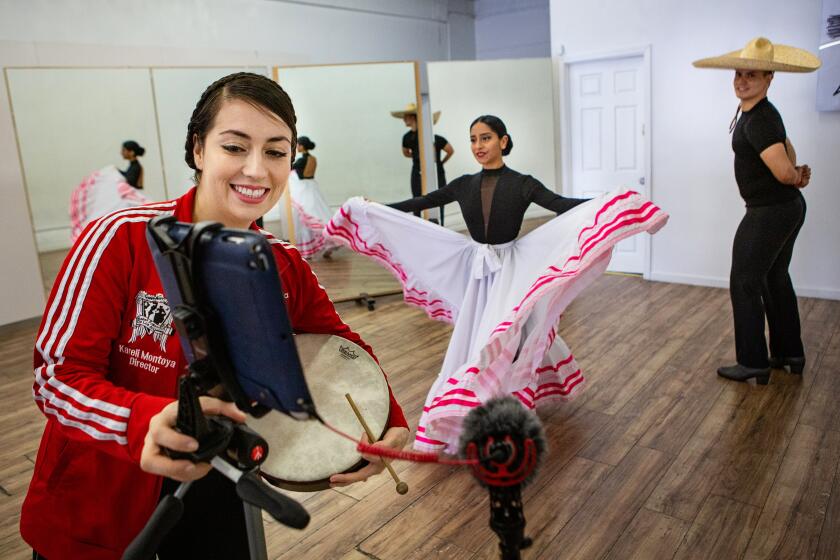Honk if you loved the dance: In Fullerton, Ballet Folklórico’s first drive-in
Ballet Folklórico de Los Ángeles performed its first drive-in performance, mixing Mexican heritage and American identity in a show for pandemic times.
Rarely has the zapateado of tapping shoes met with honking horns and flashing headlights in such a cacophony.
When Ballet Folklórico de Los Ángeles performed at the Muckenthaler Cultural Center in Fullerton, vibrant skirts flowed like waves and the audience was packed — with cars.
The company’s show Thursday night was its first drive-in performance. Audience members pressed their tickets against car windows for admission and wore masks on their way to the restroom. Dancers smiled through their own transparent personal protective equipment (Disposable plastic masks were chosen because they clamped onto the performers’ chins and could be firmly fixed during the dancing.)
In the midst of the isolating COVID-19 pandemic, the performance was intended for families, said Ballet Folklórico founder, director and choreographer Kareli Montoya.
“With the whole theme of what’s going on right now in the world, it’s gotta be for family,” she said. “We’re somehow safely together.”
“Safely together” extended to the company’s outdoor rehearsals this summer. For a month prior to the show, lines of men and women practiced traditional Mexican dances on four-by-four-foot wooden platforms to ensure proper social distancing in the studio’s parking lot — masks and face shields in place.
Montoya and her team drove the platforms to Fullerton, transferring the routines to the new setting. It was different, she said, but not difficult. After all, “everything can be modified.”
The venue, which had not hosted dancers before, originally hired only eight dancers to perform. Montoya, however, also runs Thee Academy, a Montebello-based school of folklórico, mariachi and floreo. Because of the pandemic, Thee Academy’s students hadn’t been able to perform for in-person audiences this year.
The Muck eventually agreed to host 10 adult dancers and about 16 kids. Those kids — ages 7 to 16 — had been taking online classes paired with occasional in-person, outdoor lessons.
“Most of these kids are already taking who knows how many hours of class online,” Montoya said. “So having them come at least once or twice a week in person gets them out of the house. … And even though they are together, they’re still separate, in a way.”
When Montoya was a child, her mom took her to dance classes: hip-hop, ballet, cheer, you name it. But from the moment a 6-year-old Kareli took her first folklórico class in a community park, the genre stuck. Ballet folklórico, also known as baile folklórico, consists of traditional Mexican folk dances that have come to capture the diversity of Chicano culture in L.A.

“Most people … want their kids to participate in one way or another in something that has to do with their culture, whether they’re first generation, second generation — I even have dancers who are fifth generation,” Montoya said. “I think a group like the one that I have … it gives these families a chance to introduce children and families to their roots.”
The choreographer was born in L.A. County to parents from the Mexican state of Sinaloa. Her choreography, inspired by music — she loves everything from mariachi to son jarocho, the Veracruz musical style of “La Bamba” — tends toward the traditional.
“I do consider myself Mexican but also very much American,” Montoya said. “So that’s why, even though it’s on the traditional side, sometimes I like to go outside the box and do choreography to something that Mexican Americans will relate to.”
Ballet Folklórico de Los Ángeles feels like comfort food: wonderfully familiar, even nostalgic to audiences of Mexican heritage. But it leans into American identity too.
“Like the Disney suite we’re doing — I get it, because I’ve been to Disneyland many times,” Montoya said. “And I also have very Mexican parents. So I think that having that understanding is what really shapes the choreography that I do. I can relate to both sides.”
In 2017, Montoya helped to re-create the “Tale as Old as Time” scene from “Beauty and the Beast,” mariachi style, for Latino media company mitú. Her husband, who co-owns the dance studio and directs the group Mariachi Garibaldi, crafted the music.

That number was performed at Thursday’s show, Belle’s golden dress twirling through the night air.
Ballet Folklórico de Los Ángeles may have gotten its widest exposure performing at the premiere of the Pixar movie “Coco” at the El Capitan Theatre and later at the 90th Academy Awards.
Brimming with nerves and excitement, Montoya worked alongside “La La Land” choreographer Mandy Moore to design the performance.
“My job was to show her the authentic side of it so that it wouldn’t become something completely different,” Montoya said. “I was able to come up with a good little task force for the Oscars. But even then, you only get one chance.”

Montoya said she felt intense pressure because she was representing her culture in front of thousands at the Dolby Theatre and millions more watching at home.
“For me, it was really, really nerve-racking — more on the side of how Mexican Americans and Mexicans were going to see the performance,” Montoya said. “Because it wasn’t traditional, you know? Most people were like, ‘Oh, this is great. We have something of ours on the stage, being seen by a lot of people.’”
Since then, her company filmed “A Celebration of the Music From Coco” at the Hollywood Bowl last November. The live-to-film concert was released on the streaming service Disney+ in April and marked a career highlight for Montoya, reflecting her love of tradition and her departure from it — ballet folklórico that pulses with Mexican and American energies.

The performance at “the Muck” came less than a week before Mexican Independence Day, which on Wednesday kicked off Latino Heritage Month. Of Thursday’s show she said, “The whole program is a celebration of my people. From beginning to end.”
The coronavirus crisis forced dance companies — folklórico, ballet, modern — to find ways to make money and reach audiences. Think screens, not stages.
More to Read
The biggest entertainment stories
Get our big stories about Hollywood, film, television, music, arts, culture and more right in your inbox as soon as they publish.
You may occasionally receive promotional content from the Los Angeles Times.













